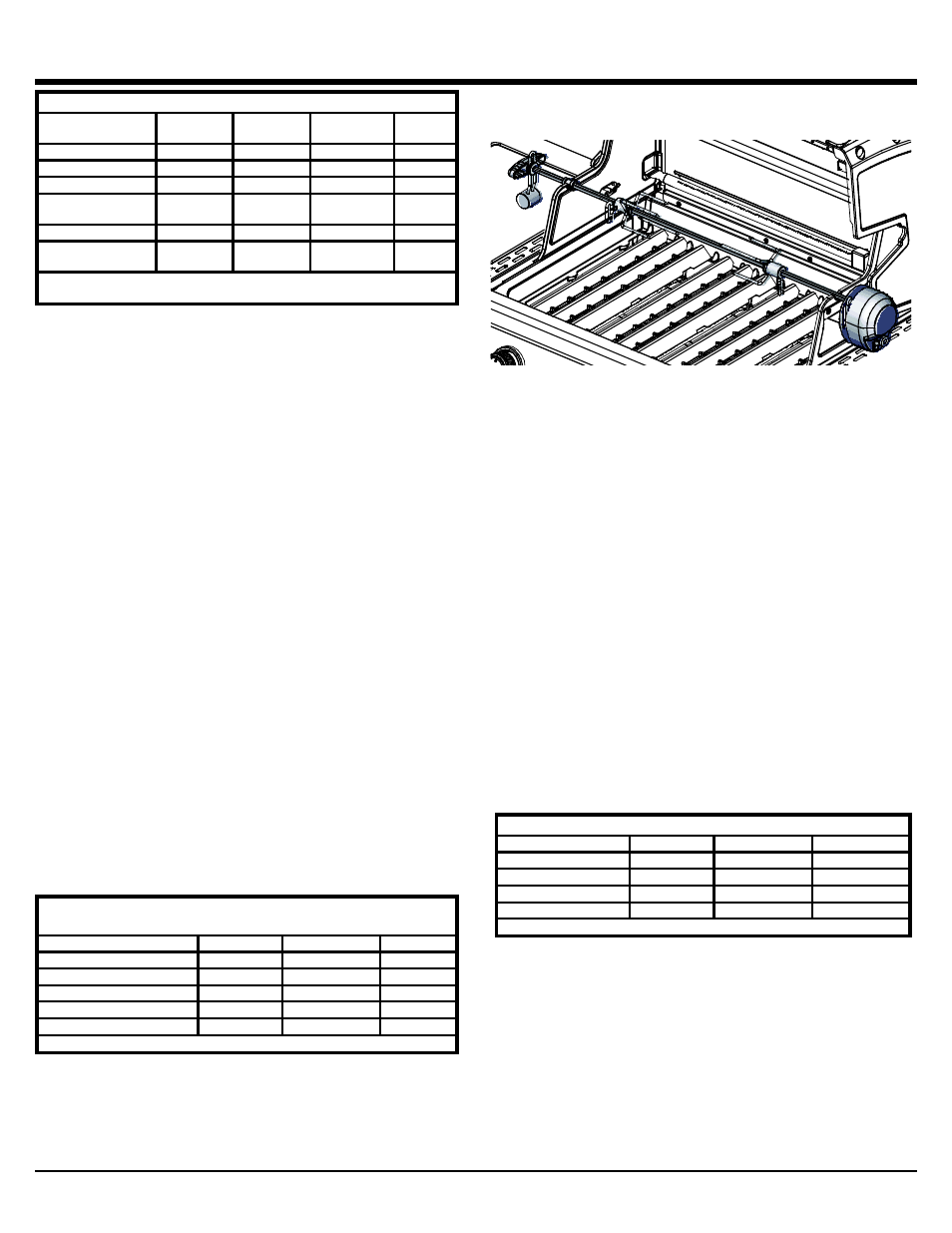20094-40lp rev k (english) pg08, Cooking techniques, Indirect convection cooking – Broil King Regal Regal™ S 590 Pro Freestanding Gas Grill Owner's Manual Manuel d'utilisation
Page 8: Rotisserie cooking, Rear burner rotisserie

COOKING TECHNIQUES
8
DIRECT GRILLING GUIDE
1” THICK
HEAT
SETTING
TIME PER
SIDE
TOTAL
MINUTES
CHICKEN
MED / WELL MED / LOW
4 / 4 / 4 / 4
16
CHICKEN WINGS
MED / WELL MED / LOW
5 / 5 / 5 / 5
20
HAMBURGER
MEDIUM
MED / LOW
3 / 3 / 3 / 3
12
HAMBURGERS
3/4” FROZEN
MEDIUM
MED / LOW
3 / 3 / 3 / 3
12
FISH FILLET
MEDIUM
MEDIUM
2 / 2 / 2 / 2
8 – 10
LOBSTER TAILS
SPLIT
MEDIUM
MEDIUM
4 / 4 / 4 / 4
16 - 20
USE SAME TECHNIQUE AS THE PERFECT STEAK GRILLING GUIDE
(PAGE 7).
INDIRECT CONVECTION COOKING
This method is ideal for cooking large cuts of meat such as
roasts or poultry. The food is cooked by hot air circulating
around it.
1. For most applications of convection cooking with and
without a rotisserie, a drip pan is recommended to catch
the drippings. Place drip pan on top of the Flav-R-Wave,
beneath center of food. Put half to one inch of water in
the drip pan. Fruit juice, wine or marinade may also be
added to enhance the flavor. Do not let the drip pan run
dry.
2. Convection cooking without a rotisserie is best with the
lid closed and the heat reduced. All burners can be set
to low or the outside burners can be set to medium and
the middle burner(s) can be turned off. Turning the
center burner off will prevent juices in the drip pan from
burning.
3. Prior to placing the meat on the gas grill, baste the meat
with vegetable oil. This will enhance browning on the
outside of the meat.
4. When cooking without a drip pan, close attention must
be paid to avoid the risk of a grease fire and is not
recommended.
5. Turn gas grill off and allow it to cool before removing drip
pan. The fat drippings are highly flammable and must be
handled carefully to avoid injury.
6. For convection cooking roasts and poultry without a
rotisserie, put meat in a roasting rack directly on grids.
INDIRECT CONVECTION AND
ROTISSERIE COOKING GUIDE
BEEF ROAST
3 - 6 Lb.
MED / LOW
2 – 4 HRS
BEEF ROAST
6 - 10 Lb.
MED / LOW
3 – 5 HRS
PORK ROAST
2 - 5 Lb.
MED / LOW
2 – 4 HRS
PORK ROAST
6 - 10 Lb.
MED / LOW
3 – 5 HRS
TURKEY OR CHICKEN
2 - 5 Lb.
MED / LOW
2 – 4 HRS
TURKEY OR CHICKEN
5 - 10 Lb.
MED / LOW
3 – 5 HRS
WHEN USING ROTISSERIE BURNER, SET HEAT AT MED / HIGH
ROTISSERIE COOKING
Follow the steps for Indirect Convection Cooking. (See left)
1. The rotisserie can accommodate up to 7 kg (15lb) of
meat with the limiting factor of rotating clearance. For
best results the meat should be centered on the center
line of spit to eliminate an out-of-balance condition.
2. The rotisserie can be used with the cooking grids in place
if space allows.
3. Fasten the meat securely on the spit prior to placing it on
the gas grill. For poultry, tie the wings and legs in tightly.
REAR BURNER ROTISSERIE
1. Certain models feature a rear burner for rotisserie
cooking. The rear burner rotisserie method is the
ultimate for cooking roasts and poultry. With the heat
source located behind the food, there is no chance of a
flare up caused by fat drippings. A dish or drip pan
placed below the spit will collect the juices for basting or
for preparing a sauce.
2. The spring loaded rear burner may be easily removed
when not in use.
3. To operate your rear burner, see “Lighting the Rear
Burner.” (Page 6)
MEAT TEMPERATURE GUIDE
RARE
MED
WELL
BEEF / LAMB / VEAL
130°F / 55°C
146°F / 63°C
160°F / 70°C
PORK
150°F / 65°C
170°F / 77°C
POULTRY
170°F / 77°C
HAMBURGER
160°F / 70°C
FOR BEST RESULTS, USE A MEAT THERMOMETER
- Regal Regal™ S420 Pro Freestanding Gas Grill Owner's Manual Signet Signet™ 390 Freestanding Gas Grill Owner's Manual Crown Crown™ 490 Freestanding Gas Grill User Guide Crown Crown™ 440 Freestanding Gas Grill User Guide Monarch™ 390 Freestanding Gas Grill User Guide Monarch Monarch™ 320 Freestanding Gas Grill User Guide Gem Gem™ 310 Freestanding Gas Grill Owner's Manual Regal Regal™ S510 Commercial Freestanding Gas Grill Owner's Manual